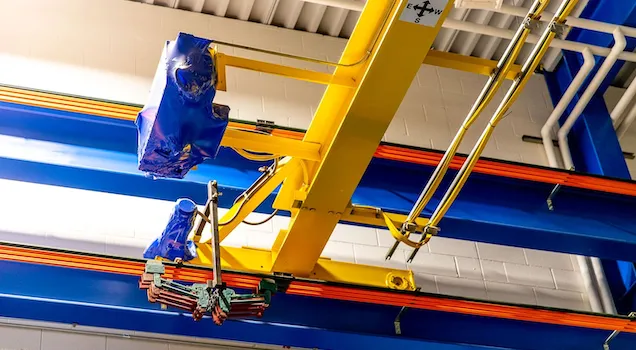
By Annette Harris July 10, 2024
Collected at: https://www.plantengineering.com/articles/how-to-employ-ai-and-ml-to-reduce-crane-accidents-enhance-efficiency/
Traditionally, cranes require manual operation, with skilled operators at the helm controlling movements and managing loads. The shift to crane automation introduces artificial intelligence (AI), machine learning (ML) and other technology to perform these tasks, typically with minimal human oversight. This transition not only minimizes human error but also bolsters operational efficiency.
As AI and ML continue to transform the landscape of crane operations, there are several key benefits which have emerged including:
Enhanced precision: Algorithms process extensive data from sensors and cameras, making real-time decisions about the crane’s movements and load management. Such precision is invaluable in environments such as shipping docks, where the exact placement of containers can significantly expedite processes and alleviate congestion.
Improved safety: AI advances safety measures by predicting and preventing potential accidents. ML models, for instance, analyze historical accident data to discern patterns and foresee risk factors. This predictive capability trains the crane’s AI systems to circumvent similar future incidents.
Another way AI enhances safety is by monitoring environmental conditions and then adapting crane operations to mitigate accident risks due to factors like wind or structural weaknesses.
Increased efficiency: By automating routine tasks, cranes can operate continuously, bypassing the need for breaks typical with human operators, thus accelerating operations. AI further refines efficiency by optimizing paths and movements based on real-time data, which curtails fuel consumption and reduces wear on machinery.

Harnessing the power of artificial intelligence, industrial cranes are transforming the landscape of construction, offering smarter, safer and more reliable operations. Courtesy: American Equipment
Implementing AI in crane automation
The process of integrating AI into crane automation is structured and methodical. Each stage is critical to enhancing the precision and safety of crane operations through intelligent automation.
Data acquisition and analysis: AI implementation in crane automation starts with gathering data from various sources such as sensors, GPS and operational logs. Analyzing this data helps understand patterns and train ML models, optimizing future operations based on insights about load weight, crane speed and weather conditions.
Machine learning models: Developing robust ML models is essential for effective automation. These models, trained on historical data, predict and execute tasks with high precision and safety, improving with each comprehensive data set.
Real-time decision making: Deployed AI systems use real-time data to make autonomous decisions. For example, if sensors detect an overload or imbalance, the AI system can immediately halt operations or adjust the crane’s movement to redistribute the weight. This proactive management helps maintain a smooth workflow and prevent accidents.
The importance of inspection, maintenance and modernization services
Regular inspection, maintenance and modernization are crucial for the optimal performance and safety of automated cranes. Partnering with crane service specialists is vital for maximizing the efficiency, safety and longevity of these machines.
Here’s a look at three ways these services contribute to crane operations:
1. Crane inspection: a critical preventive measure
Regular inspections are paramount for identifying issues before they evolve into major failures. These evaluations are meticulously focused on:
- Conducting thorough checks for any signs of wear or structural damage that could compromise the crane’s functionality.
- Verifying that all mechanical and electrical components are in optimal working condition. This is vital to maintain the crane’s operational integrity and to preempt potential malfunctions.
- Confirming that the crane can handle its maximum designated load safely. This testing is essential to validate the operational safety standards of the crane under various load conditions.
2. Crane maintenance: sustaining performance and reliability
Routine maintenance is essential to extend the operational life span of cranes and to minimize the likelihood of disruptions. Detailed maintenance protocols include:
- Lubricating all moving parts regularly to decrease wear and enhance longevity.
- Replacing worn or damaged components proactively to prevent unexpected failures. This practice is crucial for maintaining continuous operation and averting downtime.
- Updating control software routinely to maintain peak performance and compatibility with current operating systems and technologies.
3. Crane modernization: keeping pace with technological advancements
To keep older cranes performing efficiently and effectively, modernization is key. This process involves upgrading various aspects of the crane’s technology:
- Installing the latest automated controls to improve functionality and integration with modern operational frameworks.
- Incorporating advanced sensors to enhance monitoring capabilities and operational diagnostics. These sensors play a critical role in providing the data necessary for real-time decision making and performance optimization.
- Upgrading software to the latest versions to boost efficiency and safety. This includes implementing cutting-edge algorithms that can predict potential issues and streamline crane operations.
AI and ML for crane automation going forward
While the benefits are significant, integrating AI and ML into crane automation comes with challenges, including data privacy concerns, cybersecurity risks and substantial initial investments. Furthermore, integrating new technology with existing infrastructure poses its own set of challenges.
However, the future of crane automation is promising. As technology progresses, automated cranes will become even more capable. Continued research and development are expected to introduce more sophisticated AI applications in crane operations, further enhancing their capabilities.
The landscape of crane automation is undergoing a significant transformation due to AI and ML. As industries adopt these advancements, their role in crane operation is set to expand, reshaping the future of industrial operations. This ongoing integration heralds a new era where automated cranes are central to creating smarter, safer and more efficient workplaces.

Leave a Reply